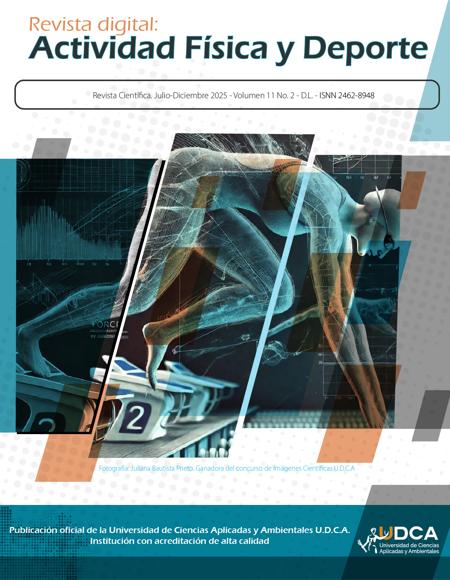Características del pie y equilibrio dinámico en futbolistas juveniles colombianos
Foot characteristics and dynamic balance in Colombian youth soccer players
Contenido principal del artículo
Resumen
Introducción: algunas variables funcionales, como el tipo de huella plantar, el mecanismo de windlass y el equilibrio dinámico, están asociadas al riesgo de lesión en la extremidad inferior en deportistas. Se hace necesario el reconocimiento de estos elementos, con el fin de identificar potenciales factores de riesgo y promover las respectivas medidas preventivas. Objetivo: describir las características del pie y el equilibrio dinámico en futbolistas juveniles colombianos. Materiales y métodos: estudio observacional y corte transversal. Participaron voluntariamente 40 futbolistas. Se evaluó el tipo de huella plantar, con el método Herzco; el mecanismo de windlass, con el test de Jack y el equilibrio dinámico, por medio del Y balance test. Para evitar que los alcances no se vieran influenciados por la altura de los participantes se normalizaron, según la medida real de miembro inferior. Resultados y discusión: se identificaron aspectos susceptibles en el equipo y posibles factores de riesgo de lesión, como la prevalencia de pies cavos y la inactivación del mecanismo windlass más de la mitad de la muestra. Algunos deportistas presentaron alto riesgo de lesión asociado al equilibrio dinámico. Conclusión: se sugiere considerar las características del pie como potenciales factores de riesgo de lesión en la extremidad inferior en futbolistas. Futuros estudios podrían explorar la relación entre el funcionamiento del pie y el equilibrio dinámico, incluyendo la exploración de variables asociadas a la composición corporal.
Palabras clave:
Descargas
Datos de publicación
Perfil evaluadores/as N/D
Declaraciones de autoría
- Sociedad académica
- Universidad de Ciencias Aplicadas UDCA
- Editorial
- Universidad de Ciencias Aplicadas y Ambientales U.D.C.A
Detalles del artículo
Referencias (VER)
ALTMAN, D.G.; DEBORAH, A. 1991. Practical statistics for medical research. Statistics in Medicine. 10(10):1635-1636. https://doi.org/10.1002/sim.4780101015
ARANGO, J.C.A.; NIETO, D.C.; RENGIFO, G.M.R. 2019. Análisis de huella plantar bajo el método Herzco. Lecturas: Educación Física y Deportes. 24(251).
ARMADA, Ó.M.; BARROSO, R.J.M.; GARCÍA, A.M.O. 2019. Efectos del vendaje Low-Dye sobre el pie: Revisión narrativa. Revista española de podología. 30(1):38-52.
BARNES, A.; WHEAT, J.; MILNER, C. 2007. Association between foot type and tibial stress injuries: A systematic review. British Journal of Sports Medicine. 42(2). https://doi.org/10.1136/bjsm.2007.036533
BULDT, A.K.; LEVINGER, P.; MURLEY, G.S.; MENZ, H.B.; NESTER, C.J.; LANDORF, K.B. 2015. Foot posture is associated with kinematics of the foot during gait: A comparison of normal, planus and cavus feet. Gait & Posture. 42(1):42-48. https://doi.org/10.1016/j.gaitpost.2015.03.004
BURNS, J.; KEENAN, A.M.; REDMOND, A. 2005. Foot Type and Overuse Injury in Triathletes. Journal of the American Podiatric Medical Association. 95(3):235-241. https://doi.org/10.7547/0950235
BUSTOS-VIVIESCAS, B.J.; DELGADO MOLINA, M.C.; ACEVEDO MINDIOLA, A.A.; RODRÍGUEZ ACUÑA, L.E.; LOZANO ZAPATA, R.E. 2020. Influencia del IMC en la huella plantar de árbitros masculinos de fútbol. Revista Cubana de Ortopedia y Traumatología. 34(1):1-23.
CAMERON, J.P.; TERALYN K., D.; EMILY H., G. 2019. The reliability of the star excursion balance test and lower quarter y-balance test in healthy adults: A systematic review. International Journal of Sports Physical Therapy. 14(5). https://doi.org/10.26603/ijspt20190683
CAMPO, M.Á.; HERNÁNDEZ, G.E.; LÓPEZ, D.E.; HINCAPIÉ, O.L.; MOSQUERA, W.; PAZ, G.M. 2022. Caracterización del equilibrio dinámico y la tipología de pie en futbolistas juveniles. Salud UIS. 54(1). https://doi.org/10.18273/saluduis.54.e:22030
CAMPO, M.A.; OÑATE, G.; SALAMANCA, D.; ESCARRIA, C.; PERDOMO, J.; SALAZAR, L. 2021. Influence of the Foot and its Characteristics on the Risk of Injury Associated with Dynamic Balance in Soccer Players: An Observational Study. Revista de Educação Física / Journal of Physical Education. 90(3). https://doi.org/10.37310/ref.v90i3.2758
CHENG, H.Y.K.; LIN, C.L.; WANG, H.W.; CHOU, S.W. 2008. Finite element analysis of plantar fascia under stretch—The relative contribution of windlass mechanism and Achilles tendon force. Journal of Biomechanics. 41(9):1937-1944. https://doi.org/10.1016/j.jbiomech.2008.03.028
COBB, S.C.; TIS, L.L.; JOHNSON, J.T.; WANG, Y.T.; GEIL, M.D.; MCCARTY, F.A. 2009. The effect of low-mobile foot posture on multi-segment medial foot model gait kinematics. Gait & Posture. 30(3):334-339. https://doi.org/10.1016/j.gaitpost.2009.06.005
COS, F.; COS, M.À.; BUENAVENTURA, L.; GRIVÉ, R.P. 2010. Modelos de análisis para la prevención de lesiones en el deporte. Estudio epidemiológico de lesiones: El modelo Union of European Football Associations en el fútbol. Apunts: Medicina de l’esport. p.95-102.
DI STASIO, G.; MONTANELLI, M. 2020. A Narrative Review on the Tests Used in Biomechanical Functional Assessment of the Foot and Leg: Diagnostic Tests of Deformities and Compensations. Journal of the American Podiatric Medical Association. 110(6). https://doi.org/10.7547/19-040
DIAZ, M.A.; GIBBONS, M.W.; SONG, J.; HILLSTROM, H.J.; CHOE, K.H.; PASQUALE, M.R. 2018. Concurrent validity of an automated algorithm for computing the center of pressure excursion index (CPEI). Gait & Posture. 59:7-10. https://doi.org/10.1016/j.gaitpost.2017.09.022
FULLER, E. 2000. The windlass mechanism of the foot. A mechanical model to explain pathology. Journal of the American Podiatric Medical Association. 90(1). https://doi.org/10.7547/87507315-90-1-35
FUSCO, A.; GIANCOTTI, G.F.; FUCHS, P.X.; WAGNER, H.; DA SILVA, R.A.; CORTIS, C. 2020. Y balance test: Are we doing it right? Journal of Science and Medicine in Sport. 23(2):194-199 https://doi.org/10.1016/j.jsams.2019.09.016
GRIBBLE, P.A.; HERTEL, J. 2003. Considerations for Normalizing Measures of the Star Excursion Balance Test. Measurement in Physical Education and Exercise Science. 7(2):89-100 https://doi.org/10.1207/S15327841MPEE0702_3
HICKS, J. 1954. The mechanics of the foot: II. The plantar aponeurosis and the arch. Journal of Anatomy. 88(1):25.
HILLSTROM, H.J.; SONG, J.; KRASZEWSKI, A.P.; HAFER, J.F.; MOOTANAH, R.; DUFOUR, A.B.; CHOW, B.S.; DELAND, J.T. 2013. Foot type biomechanics part 1: Structure and function of the asymptomatic foot. Gait & Posture. 37(3):445-451. https://doi.org/10.1016/j.gaitpost.2012.09.007
HOUCK, J.R.; TOME, J.M.; NAWOCZENSKI, D.A. 2008. Subtalar neutral position as an offset for a kinematic model of the foot during walking. Gait & Posture. 28(1):29-37. https://doi.org/10.1016/j.gaitpost.2007.09.008
HYONG, I.H.; KANG, J.H. 2016. Comparison of dynamic balance ability in healthy university students according to foot shape. Journal of Physical Therapy Science. 28(2):661-664 https://doi.org/10.1589/jpts.28.661
KAPPEL-BARGAS, A.; WOOLF, R.D.; CORNWALL, M.W.; MCPOIL, T.G. 1998. The windlass mechanism during normal walking and passive first metatarsalphalangeal joint extension. Clinical Biomechanics (Bristol, Avon). 13(3):190-194. https://doi.org/10.1016/s0268-0033(97)00038-7
KIM, J.; LIM, O.; YI, C. 2015. Difference in static and dynamic stability between flexible flat feet and neutral feet. Gait & Posture. 41(2):546-550 https://doi.org/10.1016/j.gaitpost.2014.12.012
LIU, X.; DUAN, Y.; HITZMANN, A.; XU, Y.; CHEN, T.; IKEMOTO, S.; HOSODA, K. 2018. Using the foot windlass mechanism for jumping higher: A study on bipedal robot jumping. Robotics and Autonomous Systems. 110:85-91. https://doi.org/10.1016/j.robot.2018.09.006
LUCAS, R.; CORNWALL, M. 2017. Influence of foot posture on the functioning of the windlass mechanism. The Foot. 30:38-42. https://doi.org/10.1016/j.foot.2017.01.005
MUÑOZ, J.P.; GONZÁLEZ, M.A.G.; GARCÍA, J.C.C.; NOVA, A.M. 2015. Relación de la postura del pie con las lesiones más frecuentes en atletas. Un estudio piloto. Archivos de medicina del deporte: revista de la Federación Española de Medicina del Deporte y de la Confederación Iberoamericana de Medicina del Deporte. 32(166):76-81.
NEAL, B.S.; GRIFFITHS, I.B.; DOWLING, G.J.; MURLEY, G.S.; MUNTEANU, S.E.; FRANETTOVICH SMITH, M.M.; COLLINS, N.J.; BARTON, C.J. 2014. Foot posture as a risk factor for lower limb overuse injury: A systematic review and meta-analysis. Journal of Foot and Ankle Research. 7(1). https://doi.org/10.1186/s13047-014-0055-4
NEVES, F.; DE SOUZA, C.Q.; STOFFEL, M.; PICASSO MARTINS, C.L. 2017. The Y balance test – how and why to do it? International Physical Medicine & Rehabilitation Journal. 2(4):261-262. https://doi.org/10.15406/ipmrj.2017.02.00058
PIÑEROS ÁLVAREZ, J.L.; HERNÁNDEZ OÑATE, G.E.; ARANA CRUZ, C.; LÓPEZ-SALAMANCA, D.E.; HINCAPIE-GALLON, O.L. 2021. Características del pie y equilibrio dinámico en basquetbolistas juveniles colombianos. Fisioterapia. 43(6):333-339. https://doi.org/10.1016/j.ft.2021.03.003
PLISKY, P.J.; RAUH, M.J.; KAMINSKI, T.W.; UNDERWOOD, F.B. 2006. Star Excursion Balance Test as a Predictor of Lower Extremity Injury in High School Basketball Players. Journal of Orthopedic & Sports Physical Therapy. 36(12):911-919. https://doi.org/10.2519/jospt.2006.2244
ROOS, K.; WASSERMAN, E.; DALTON, S.; GRAY, A.; DJOKO, A.; DOMPIER, T.; KERR, Z. 2017. Epidemiology of 3825 injuries sustained in six seasons of National Collegiate Athletic Association men’s and women’s soccer. British journal of sports medicine. 51(13):1029-1034. https://doi.org/10.1136/bjsports-2015-095718
SU, S.; MO, Z.; GUO, J.; FAN, Y. 2017. The Effect of Arch Height and Material Hardness of Personalized Insole on Correction and Tissues of Flatfoot. Journal of Healthcare Engineering. 2017:9. https://doi.org/10.1155/2017/8614341
SUGATHAN, H.; SHERLOCK, D. 2009. A modified Jones procedure for managing clawing of lesser toes in pes cavus: Long-term follow-up in 8 patients. The Journal of Foot and Ankle Surgery: Official Publication of the American College of Foot and Ankle Surgeons. 48(6):637-641 https://doi.org/10.1053/j.jfas.2009.07.009
TAKAHASHI, K.Z.; GROSS, M.T.; VAN WERKHOVEN, H.; PIAZZA, S.J.; SAWICKI, G.S. 2016. Adding Stiffness to the Foot Modulates Soleus Force-Velocity Behaviour during Human Walking. Scientific Reports. 6(1):29870. https://doi.org/10.1038/srep29870
THERAN, K.D.; ESPITIA, C.H.; ÁNGEL, J.A. 2017. Tipología del pie para mejorar el bienestar físico en niños futbolistas. En Calidad de Vida, Inclusión Social y Bienestar Humano. (4):112-125. https://doi.org/10.21892/9789804270215.7
TONG, J.W.K.; KONG, P.W. 2013. Association Between Foot Type and Lower Extremity Injuries: Systematic Literature Review with Meta-analysis. Journal of Orthopaedic & Sports Physical Therapy. 43(10):700-714. https://doi.org/10.2519/jospt.2013.4225
WILLIAMS, D.S.; MCCLAY, I.S.; HAMILL, J.; BUCHANAN, T.S. 2001. Lower Extremity Kinematic and Kinetic Differences in Runners with High and Low Arches. Journal of Applied Biomechanics. 17(2):153-163. https://doi.org/10.1123/jab.17.2.153
YATES, B.; WHITE, S. 2004. The Incidence and Risk Factors in the Development of Medial Tibial Stress Syndrome among Naval Recruits. The American Journal of Sports Medicine. 32(3):772-780. https://doi.org/10.1177/0095399703258776









